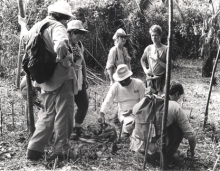What is El Pilar?
El Pilar is a living museum and laboratory drawing from ancient cultural practices to create a conservation model for the future of civilization
The monument of El Pilar today show that it was once the primary administration center for the Belize River area, filled with Maya plazas, temples and palaces that were built over a course of 15 centuries, from 500 BC to 1000 AD. How this ancient society developed, and understanding its relationship to the resources and environment of the Maya forest around it is the main objective of the Belize River Archaeological Settlement Survey (BRASS)/El Pilar Program. It is the past that will illuminate the present, and prepare a path for the future.
The major center of El Pilar was archaeologically unknown before the surveys of the BRASS project, under direction of archaeologist Anabel Ford, mapped the center and shared it with the world. BRASS fieldwork has mapped and identified residential sites, confirmed locations of centers, and gathered data on soil, topography, and vegetation. The field enterprises have been divided into a number of stages:
- The survey of the 1980s
- The detailed investigation of Maya residential and domestic architecture of 1990-92
- The initial examination of El Pilar of 1993-2003
- The development of the binational park 1994-present.
Research at El Pilar has emphasized the ancient Maya people rather than the governing elites studied at other sites. Multidisciplinary studies focus on where the Maya built their homes (settlement patterns) and how they fed their large populations (resource management).

